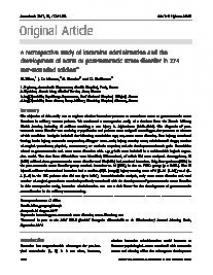A retrospective study of ketamine administration and the development of acute or post-traumatic stress disorder in 274 war-wounded soldiers
The objective of this study was to explore whether ketamine prevents or exacerbates acute or post-traumatic stress disorders in military trauma patients. We conducted a retrospective study of a database from the French Military Health Service, including all soldiers surviving a war injury in Afghanistan (2010–2012). The diagnosis of post-traumatic stress disorder was made by a psychiatrist and patients were analysed according to the presence or absence of this condition.
Analysis included the following covariables: age; sex; acute stress disorder; blast injury; associated fatality; brain injury; traumatic amputation; Glasgow coma scale; injury severity score; administered drugs; number of surgical procedures; physical, neurosensory or aesthetic sequelae; and the development chronic pain.
Covariables related to post-traumatic and acute stress disorders with a p ≤ 0.10 were included in a multivariable logistic regression model. The data from 450 soldiers were identified; 399 survived, of which 274 were analysed. Among these, 98 (36%) suffered from post-traumatic stress disorder and 89 (32%) had received ketamine. Fifty-four patients (55%) in the post-traumatic stress disorder group received ketamine vs. 35 (20%) in the no PTSD group (p < 0.001).
The 89 injured soldiers who received ketamine had a median (IQR [range]) injury severity score of 5 (3–13 [1–26]) vs. 3 (2–4 [1–6] in the 185 patients who did not (p < 0.001). At multivariable analysis, only acute stress disorder and total number of surgical procedures were independently associated with the development of post-traumatic stress disorder.
In this retrospective study, ketamine administration was not a risk factor for the development of post-traumatic stress disorder in the military trauma setting.
Geachte bezoeker,
De informatie die u nu opvraagt, kan door psychotraumanet niet aan u worden getoond. Dit kan verschillende redenen hebben,
waarvan (bescherming van het) auteursrecht de meeste voorkomende is. Wanneer het mogelijk is om u door te verwijzen naar de bron
van deze informatie, dan ziet u hier onder een link naar die plek.
Als er geen link staat, kunt u contact opnemen met de bibliotheek,
die u verder op weg kan helpen.
Met vriendelijke groet,
Het psychotraumanet-team.
In: Anaesthesia, ISSN 1365-2044 | 72 | 12 | 1476–1483
http://doi.org/10.1111/anae.14079


